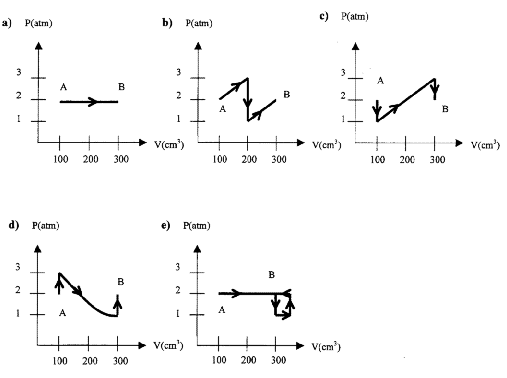University of California, San Diego
Physics 1b - Thermal Physics & Electromagnetism

 |
Physics 1B - Tutorial #3
|

- All the processes shown below have the same inital pressure (2 atm
= 2 x 105Pa) and volume (100 cm3) and end at the same
values of pressure (2 atm) and volume (300 cm3). Which diagrams
represent the same amount of work done by the system?

W =  PdV = Area
under the PV curve.
PdV = Area
under the PV curve.
a) In this case we have expansion at constant pressure; the system is
doing work on its surroundings.
W = P V (because P=const) = (2 x 105Pa) x
(200 x 10-6m3) = 40 J.
b) & c) have the same area, so the work is the same.
d) the area under the curve is somewhat less than that of a), b) & c).
e) the box at the end represents negative work (note ccw path) hence
the work is less than that of a), b) or c).
V (because P=const) = (2 x 105Pa) x
(200 x 10-6m3) = 40 J.
b) & c) have the same area, so the work is the same.
d) the area under the curve is somewhat less than that of a), b) & c).
e) the box at the end represents negative work (note ccw path) hence
the work is less than that of a), b) or c).
Starting from the point shown sketch

For each case below describe whether the diagram represents a possible
(i.e. does not violate the Laws of Thermodynamics) heat engine or
refrigerator. If not describe what is wrong.

a) This has heat transferred from high T to low T, doing work in the
process like a heat engine, except that the energy out is greater than the
energy in so it violates the First Law. IMPOSSIBLE!
b) This is a heat engine that conserves energy.
Maximum Efficiency = (TH - TC)/TH = (600K - 300K)/600K = 50%
You can get up to 5J of workl out so this is OK.
c) This violates the Second Law of Thermodynamics in a big way. You
cannot move heat from colt to hot region without putting work in.
IMPOSSIBLE.
d) This is a refrigerator, using work to move heat from cold region to
a warm region.
On a warm day your roommate suggests that you leave the refrigerator
door open to "cool this place down." After a while with the fridge door
open will the room be cooler, the same or warmer? Explain.
The initial blast of cold air may feel good, but close the door fast! This
will heat up the room further. The energy that you must use to operate the
refrigerator is transformed into heat and exhausted into the room, so more
heat is introduced into the room than is removed. Note that an air
conditioner exhausts the heat to the outdoors. OK

 Physics 1B Home
Physics 1B Home
 Tutorials
Tutorials
 Tutorial #2
Tutorial #2
 Tutorial #4
Tutorial #4
Gene Smith
Last
modified: Thurs., 20 Apr 2000



 PdV = Area
under the PV curve.
PdV = Area
under the PV curve.
 V (because P=const) = (2 x 105Pa) x
(200 x 10-6m3) = 40 J.
V (because P=const) = (2 x 105Pa) x
(200 x 10-6m3) = 40 J.



![]() Physics 1B Home
Physics 1B Home
![]() Tutorials
Tutorials
![]() Tutorial #2
Tutorial #2
![]() Tutorial #4
Tutorial #4